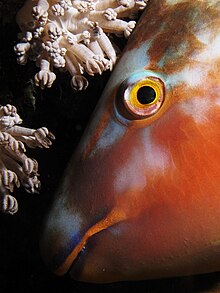Hipposcarus harid
| Hipposcarus harid | |
|---|---|

| |
| Sleeping Hipposcarus harid from the Red Sea, Egypt | |
| Scientific classification | |
| Domain: | Eukaryota |
| Kingdom: | Animalia |
| Phylum: | Chordata |
| Class: | Actinopterygii |
| Order: | Labriformes |
| Family: | Scaridae |
| Genus: | Hipposcarus |
| Species: | H. harid
|
| Binomial name | |
| Hipposcarus harid (Forsskål, 1775)
| |
| Synonyms[2] | |
| |

Hipposcarus harid, the Longnose parrotfish or Candelamoa parrotfish, is a species of marine ray-finned fish, a parrotfish from the family Scaridae found on coral reefs of Indian Ocean and the Red Sea.[2][3]
Distribution[edit]
Hipposcarus harid is found in the western Indian Ocean from the Red Sea south to the Mozambique Channel, including Madagascar, the Seychelles and east to Sri Lanka, the Maldives and the Chagos Islands.[2]
Habitat and biology[edit]
Hipposcarus harid occurs in coastal regions and is associated with coral reefs and reef flats. This species forms harems comprising a terminal phase, or male, individual and numerous initial phase individuals. It will also form large schools for foraging.[1] H. harid is a protogynous hermaphrodite in which there are two distinct phases, an initial phase which includes females and primary, that is males which were born male, and a terminal phase, the secondary males transformed from females.[4] It is an oviparous species in which the male and female form pairs for mating. It feeds on benthic algae.[2]
Human usage[edit]
Hipposcarus harid is caught with nets and other artisanal gear, the catch is maistly marketed fresh.[1] Each year in April these fish aggregate in a shallow lagoon in the Farasan Islands in the southern Red Sea. The reason for this aggregation is unknown but the local people celebrate a festival, called Hareed, catching the fish for prizes. Almost all the fish are caught but the aggregation returns each year.[5] Evidence for the consumption and trade of this species, among other parrotfishes native to the Red Sea, goes back to at least the Byzantine period.[6]
References[edit]
- ^ a b c Choat, J.H.; Carpenter, K.E.; Clements, K.D.; Rocha, L.A.; Russell, B.; Myers, R.; Lazuardi, M.E.; Muljadi, A.; Pardede, S.; Rahardjo, P. (2012). "Hipposcarus harid". IUCN Red List of Threatened Species. 2012: e.T190733A17779418. doi:10.2305/IUCN.UK.2012.RLTS.T190733A17779418.en. Retrieved 20 November 2021.
- ^ a b c d Froese, Rainer; Pauly, Daniel (eds.) (2019). "hippocampus harid" in FishBase. August 2019 version.
- ^ WoRMS - World Register of Marine Species - Hipposcarus harid (Forsskål, 1775)
- ^ T. El-Sayed Ali; A. M. Osman; S. H. Abdel-Aziz & F. A. Bawazeer (2010). "Growth and longevity of the protogynous parrotfish, Hipposcarus harid, Scarus ferrugineus and Chlorurus sordidus (Teleostei, Scaridae), off the eastern coast of the Red Sea". Journal of Applied Ichthyology. 27 (3): 840–846. doi:10.1111/j.1439-0426.2010.01566.x.
- ^ Julia Spaet (2013). "Predictable annual aggregation of longnose parrotfish (Hipposcarus harid) in the Red Sea". Marine Biodiversity. 43 (3): 179–180. doi:10.1007/s12526-013-0162-7. S2CID 9153829.
- ^ Rachel Blevis; Guy Bar-Oz & Irit Zohar (2019). "The role of Red Sea Parrotfish (Scaridae) as Trade Indicators in the Negev Desert during the Byzantine-Islamic Transition Period". International Council for Archaeozoology.
External links[edit]
- Photos of Hipposcarus harid on Sealife Collection

